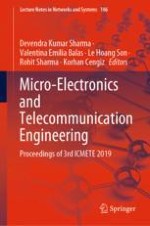2020 | Book
Micro-Electronics and Telecommunication Engineering
Proceedings of 3rd ICMETE 2019
Editors: Dr. Devendra Kumar Sharma, Prof. Valentina Emilia Balas, Prof. Dr. Le Hoang Son, Dr. Rohit Sharma, Dr. Korhan Cengiz
Publisher: Springer Singapore
Book Series : Lecture Notes in Networks and Systems
